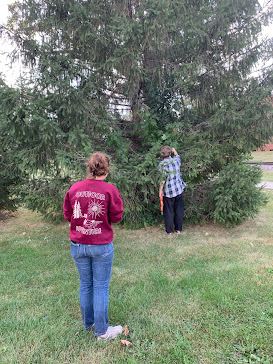As humans continue to take control over an ever-increasing amount of natural and semi-natural spaces through acts such as deforestation and urbanization, we inevitably change the habitats of all the other organisms living there. Although organisms, including plants and animals, can persist in these severely altered landscapes, their populations are oftentimes quite fragmented. In light of this, Benítez-Malvido & Martínez-Ramos (2003) (found here) became curious about the ways that forest fragmentation in the Amazon Rainforest impacts the plant communities that live under these tree canopies, particularly as fragmentation alters community structure, reproduction, demography, and reduces biodiversity (Dubois & Cheptou, 2017).
To study the impacts of fragmentation, Benítez-Malvido & Martínez-Ramos (2003) isolated 11 different fragments of forest of either 1 ha, 10 ha, or 100 ha that were all located within cattle ranches, a major source of fragmentation and habitat destruction in the Amazon Rainforest. They also had access to a continuous forest that was still near agricultural lands, but not fragmented by it.
Benítez-Malvido & Martínez-Ramos (2003) found showed that species richness was significantly higher in the continuous forest compared to the fragments, and, in fact, the researchers were unable to record the entire richness of the continuous forest as it was so vast. Further, the overall trend shows that the smaller the plot, the lower the species richness. Surprisingly, the researchers also note that fragments that were closer together did not have greater similarity to each other than fragments that were farther apart. Instead, fragment size made the greatest difference for species composition. The only species that this did not hold true for was a tree species in the Burseraceae family that became dominant in all sites, regardless of size. The researchers suggest that traits such as high reproduction independent of the environment, successful germination, using generalist pollinators, stress-tolerant seedlings, and resistance to natural enemies may be the best indicators of why a species may still be able to flourish in fragmentation.
Although Iowa is not the Amazon (sorry to break the news..), these questions are still pertinent to our urban fragmented tree clusters and solo trees that harbor understory plant communities. Here on campus, our fragments are separated by regularly mowed grass and, further beyond, surrounded by oceans of agricultural fields. We have sampled under 41 Spruce trees thus far, and we are paying attention to the total area of the plant community under the tree, the plant community’s distance to the nearest spruce’s plant community, and keeping records of the species we see under each tree. Although we are not comparing our tree fragments to a continuous forest, we are still looking at similar trends as Benítez-Malvido & Martínez-Ramos (2003), including similarity of plant community composition based on distance from other communities and species richness based on location on campus and total area of the plant growth under the trees. Additionally, we are looking for general trends that give insight into which plants perform best under disturbance conditions, which we can take into account as some of the spruce trees have foot traffic and potential mowing under them, while others do not due to low branches creating protection. I am curious if we will discover similar results to Benítez-Malvido & Martínez-Ramos (2003), perhaps showing an importance of area under the trees for diversity and no significant difference based on proximity to other plots, or perhaps our “urban” Iowa understory plants may reveal different trends.
Benítez-Malvido, J., Martínez-Ramos, M. (2003). Impact of forest fragmentation on understory plant species richness in Amazonia. Conservation Biology, 17(2), 389-400.
Dubois, J., Cheptou, P.O. (2017). Effects of fragmentation on plant adaptation to urban environments. Philosophical Transactions of the Royal Society: Biological Sciences, 372, 1-8.


Did the authors of this study mention any possible mitigation strategies for this issue beyond reducing habitat fragmentation? What do you think about corridors connecting habitats: might this help increase species richness?
ReplyDelete